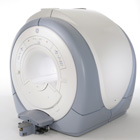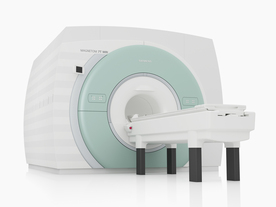 | Info
Sheets |
| | | | | | | | | | | | | | | | | | | | | | | | |
 | Out-
side |
| | | | |
|
| | | | |
Result : Searchterm 'Contrast Enhanced MRI' found in 1 term [ ] and 14 definitions [ ] and 14 definitions [ ], (+ 16 Boolean[ ], (+ 16 Boolean[ ] results ] results
| previous 16 - 20 (of 31) nextResult Pages :  [1] [1]  [2 3] [2 3]  [4 5 6 7] [4 5 6 7] |  | |  | Searchterm 'Contrast Enhanced MRI' was also found in the following services: | | | | |
|  |  |
| |
|

The company changed its name from Advanced Magnetics, Inc. to AMAG Pharmaceuticals, Inc. in July 2007.
AMAG Pharmaceuticals, Inc., a biopharmaceutical company, developed and manufactured organ-specific diagnostic contrast agents that provide clearer images during magnetic resonance imaging ( MRI) tests used to detect tumors and other abnormalities.
The company had two MRI related products on the market: Feridex I.V. (for the diagnosis of liver lesions) and GastroMARK (used for bowel and abdominal MR imaging). In November 2008, AMAG Pharmaceuticals, Inc. decided to discontinue the manufacturing of Feridex. The development of Combidex as a contrast agent for lymph disease has also been stopped.
The Company has now two commercial products: Feraheme® and GastroMARK®.
Feraheme® is the trade name of Ferumoxytol (formerly Code 7228) and is indicated for the treatment of iron deficiency anemia. Feraheme® is also being developed as a diagnostic agent for vascular- enhanced magnetic resonance imaging ( MRI) to assess peripheral arterial disease.
MRI Contrast Agents:
Contact Information
MAIL
AMAG Pharmaceuticals, Inc.
61 Mooney St.
Cambridge, MA 02138
USA
| |  | |
• View the NEWS results for 'AMAG Pharmaceuticals, Inc.' (7).
| | | | |  Further Reading: Further Reading: | | Basics:
|
|
News & More:
| |
| |
|  | |  |  |  |
| |
|

From GE Healthcare;
The Signa HDx MRI system is GE's leading edge whole body magnetic resonance scanner designed to support high resolution, high signal to noise ratio, and short scan times.
Signa HDx 3.0T offers new technologies like ultra-fast image reconstruction through the new XVRE recon engine, advancements in parallel imaging algorithms and the broadest range of premium applications. The HD applications, PROPELLER (high-quality brain imaging extremely resistant to motion artifacts), TRICKS ( contrast- enhanced angiographic vascular lower leg imaging), VIBRANT (for breast MRI), LAVA (high resolution liver imaging with shorter breath holds and better organ coverage) and MR Echo (high-definition cardiac images in real time) offer unique capabilities.
Device Information and Specification CLINICAL APPLICATION Whole body
CONFIGURATION Compact short bore SE, IR, 2D/3D GRE, RF-spoiled GRE, 2DFGRE, 2DFSPGR, 3DFGRE, 3DFSPGR, 3DTOFGRE, 3DFSPGR, 2DFSE, 2DFSE-XL, 2DFSE-IR, T1-FLAIR, SSFSE, EPI, DW-EPI, BRAVO, Angiography: 2D/3D TOF, 2D/3D phase contrast vascular IMAGING MODES Single, multislice, volume study, fast scan, multi slab, cine, localizer H*W*D 240 x 2216,6 x 201,6 cm POWER REQUIREMENTS 480 or 380/415, 3 phase ||
COOLING SYSTEM TYPE Closed-loop water-cooled grad. | |  | | | |
|  | |  |  |  |
| |
|

From Siemens Medical Systems;
The MAGNETOM 7T is designed as an open research platform. 7T MRI provides anatomical detail at the submillimiter scale, enhanced contrast mechanisms, outstanding spectroscopy performance, ultra-high resolution functional imaging ( fMRI), multinuclear whole-body MRI and functional information.
This ultra high field (UHF) MRI device is a research system and not cleared, approved or licensed in any jurisdiction for patient examinations.
Device Information and Specification
CLINICAL APPLICATION
Whole body
High-performance, ultra high field coils available. Integration and support for coil developments.
CHANNELS (min. / max. configuration)
32, optional 8 channels TX array
40 x 40 x 30 cm³ less than 8% nonlinearity
MAGNET WEIGHT (gantry included)
35017 kg
DIMENSION H*W*D (gantry included)
320 x 240 x 317,5 cm
MAX. AMPLITUDE
up to 70 mT/m
Up to 3rd order shim coils, user configurable B0 shim ? B0 maps and ROI definition
POWER REQUIREMENTS
2000 Volts, 650A
| |  | | | |  Further Reading: Further Reading: | | Basics:
|
|
News & More:
| |
| |
|  |  | Searchterm 'Contrast Enhanced MRI' was also found in the following services: | | | | |
|  |  |
| |
|
( MRA) Magnetic resonance angiography is a medical imaging technique to visualize blood filled structures, including arteries, veins and the heart chambers. This MRI technique creates soft tissue contrast between blood vessels and surrounding tissues primarily created by flow, rather than displaying the vessel lumen. There are bright blood and black blood MRA techniques, named according to the appearance of the blood vessels. With this different MRA techniques both, the blood flow and the condition of the blood vessel walls can be seen. Flow effects in MRI can produce a range of artifacts. MRA takes advantage of these artifacts to create predictable image contrast due to the nature of flow.
Technical parameters of the MRA sequence greatly affect the sensitivity of the images to flow with different velocities or directions, turbulent flow and vessel size.
This are the three main types of MRA:
All angiographic techniques differentially enhance vascular MR signal. The names of the bright blood techniques TOF and PCA reflect the physical properties of flowing blood that were exploited to make the vessels appear bright. Contrast enhanced magnetic resonance angiography creates the angiographic effect by using an intravenously administered MR contrast agent to selectively shorten the T1 of blood and thereby cause the vessels to appear bright on T1 weighted images.
MRA images optimally display areas of constant blood flow-velocity, but there are many situations where the flow within a voxel has non-uniform speed or direction. In a diseased vessel these patterns are even more complex. Similar loss of streamline flow occurs at all vessel junctions and stenoses, and in regions of mural thrombosis. It results in a loss of signal, due to the loss of phase coherence between spins in the voxel.
This signal loss, usually only noticeable distal to a stenosis, used to be an obvious characteristic of MRA images. It is minimized by using small voxels and the shortest possible TE. Signal loss from disorganized flow is most noticeable in TOF imaging but also affects the PCA images.
Indications to perform a magnetic resonance angiography ( MRA):
•
Detection of aneurysms and dissections
•
Evaluation of the vessel anatomy, including variants
•
Blockage by a blood clot or stenosis of the blood vessel caused by plaques (the buildup of fat and calcium deposits)
Conventional angiography or computerized tomography angiography (CT angiography) may be needed after MRA if a problem (such as an aneurysm) is present or if surgery is being considered.
See also Magnetic Resonance Imaging MRI. | | | | | | | | | | |
• View the DATABASE results for 'Magnetic Resonance Angiography MRA' (3).
| | |
• View the NEWS results for 'Magnetic Resonance Angiography MRA' (10).
| | | | |  Further Reading: Further Reading: | Basics:
|
|
News & More:
| |
| |
|  | |  |  |  |
| |
|
(NSF) Nephrogenic systemic fibrosis is a rare and highly debilitating disorder that involves extensive thickening and hardening of the skin with fibrotic nodules and plaques.
MRI contrast media have very low side effects, but accumulating data indicate that gadolinium-based contrast agents increase the risk for the development of NSF among patients with severe renal insufficiency or renal dysfunction due to the hepato-renal syndrome or in the perioperative liver transplantation period.
Due to this reason, gadolinium contrast agents are now considered contraindicated in patients with an estimated glomerular filtration rate fewer than 30 mL/min/1.73m 2.
In these patients, avoid use of gadolinium-based contrast agents unless the diagnostic information is essential and not available with non- contrast enhanced magnetic resonance imaging ( MRI).
Recognized or possibly associated factors for NSF:
•
high dose of erythropoietin;
•
high serum phosphate levels;
•
high serum calcium levels;
•
major surgery, infection, vascular event;
•
history of hypothyroidism;
When administering a gadolinium-based contrast agent, do not exceed the recommended dose and allow a sufficient period of time for elimination of the contrast medium from the body prior to any readminstration. Screen all patients for renal dysfunction by obtaining a history and/or laboratory tests.
See also Contrast Medium, Adverse Reaction, MRI Risks, MRI Safety, Ionic Intravenous Contrast Agents, Nonionic Intravenous Contrast Agents, and Contraindications.
| |  | |
• View the DATABASE results for 'Nephrogenic Systemic Fibrosis' (13).
| | |
• View the NEWS results for 'Nephrogenic Systemic Fibrosis' (8).
| | | | |  Further Reading: Further Reading: | Basics:
|
|
News & More:
| |
| |
|  | |  |  |
|  | | |
|
| |
 | Look
Ups |
| |